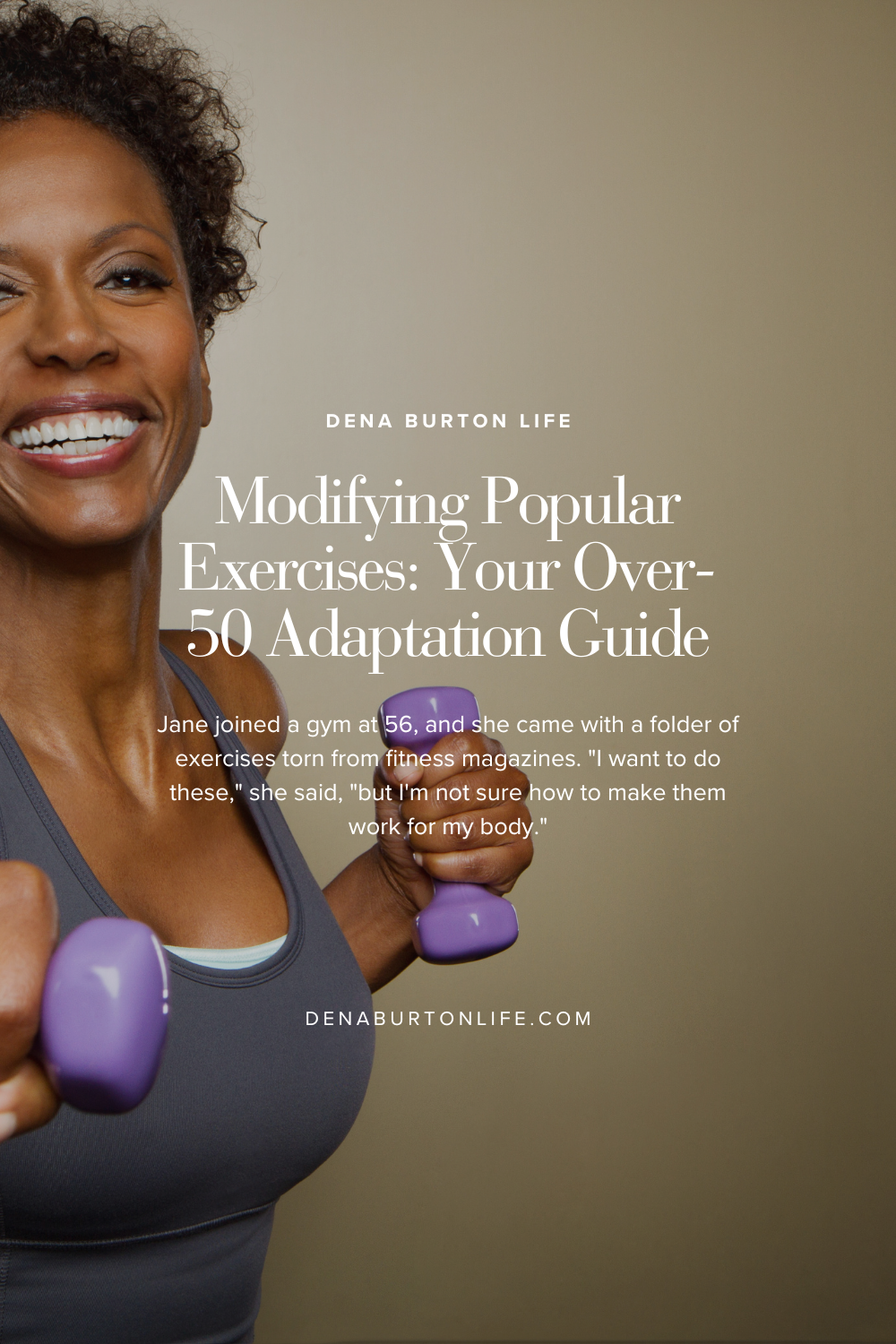Modifying Popular Exercises: Your Over-50 Adaptation Guide
Jane joined a gym at 56, and she came with a folder of exercises torn from fitness magazines. "I want to do these," she said, "but I'm not sure how to make them work for my body."
Her question reflects what I hear from women over 50 every day. The desire to stay strong and active doesn't diminish with age, but sometimes our approach needs thoughtful adaptation.
The Adaptation Mindset: Modification Isn't Compromise
First, let's reframe how we think about exercise modifications. They aren't "lesser" versions of "real" exercises. They're intelligent adjustments that respect your body's current capabilities while still providing effective stimulus for strength, mobility, and function.
When correctly approached, modifications often deliver superior results because they:
Respect joint comfort and structural realities
Allow proper muscle engagement
Enable consistent practice without setbacks
Build confidence through successful progression
The goal isn't to indefinitely avoid challenging movements. It's to create a sustainable progression that respects where your body is today while building toward greater capacity tomorrow.
Key Principles for Effective Exercise Modification
Before diving into specific exercises, let's establish fundamental adaptation principles that apply universally:
1. Respect Joint History Your joints have accumulated decades of life experience. Previous injuries, occupational patterns, and natural anatomical variations all influence how movements should be modified. Honor this history rather than fighting against it.
2. Prioritize Form Over Range Complete range of motion is valuable, but not at the expense of proper alignment. Work within the range where you can maintain optimal positioning, gradually expanding from this foundation.
3. Distribute Load Appropriately Exercises that concentrate force through a single joint often benefit from modifications that distribute that force more broadly, reducing pressure on vulnerable structures.
4. Build Requisite Mobility Before Strength Many movements require specific mobility before they can be loaded safely. Ensure you have the necessary motion before adding resistance.
5. Progress Methodically The path from modification to traditional execution isn't one large leap – it's a series of small progressions, each building upon established success.
With these principles in mind, let's explore adaptations for common exercise categories that can challenge bodies over 50.
Popular Exercise Adaptations: Lower Body
Squats: From Painful to Powerful
Standard squats can challenge knees, hips, and lower backs that have lived a full life. These modifications maintain the benefits while respecting your body's unique needs:
Box/Chair Squat Progression:
Begin with a higher surface (standard chair height)
Focus on controlled lowering and deliberate standing
Gradually reduce height as strength and comfort improve
Maintain proper knee alignment throughout
Key Form Adaptations:
Widen stance slightly if hip mobility is limited
Allow greater forward lean if ankle mobility restricts depth
Use arms as counterbalance by extending forward
Consider heel elevation (small plate or wedge) for ankle restrictions
Joint-Friendly Loading Options:
Hold weight at chest (goblet position) rather than on shoulders
Use resistance bands around knees for adductor engagement
Incorporate pause at bottom position instead of increasing weight
Consider safety bar or front rack positions if available
Lunges: Stability Without Strain
Lunges challenge balance and place significant stress on the forward knee. These adaptations make them accessible without sacrificing effectiveness:
Static Lunge Progression:
Begin with supported split stance (holding counter/chair)
Progress to unassisted split squats
Advance to rear-foot-elevated split squats
Eventually transition to moving variations if desired
Key Form Adaptations:
Reduce depth based on knee and hip comfort
Shorten stance for greater stability
Focus on vertical torso to reduce knee stress
Step at 11:00 and 1:00 angles (vs. directly forward) if hip discomfort occurs
Balance Enhancement Options:
Perform near wall or sturdy surface for occasional touch
Use walking poles or similar support
Practice toe-touch lunges before full variations
Focus on consistency rather than depth initially
Popular Exercise Adaptations: Upper Body
Push-Ups: Building Strength Systematically
Traditional push-ups challenge wrists, shoulders, and core simultaneously. These modifications create an intelligent progression path:
Angle Progression Approach:
Begin with wall push-ups (most upright)
Progress to counter or stable chair
Advance to bench or elevated surface
Eventually transition to floor variations
Key Form Adaptations:
Use parallel bars or push-up handles for wrist comfort
Position elbows at 45° angle (vs. straight out) for shoulder health
Consider slight range limitation if shoulder pain occurs at depth
Maintain whole-body alignment regardless of variation
Core Integration Strategies:
Focus on maintaining pelvic position throughout movement
Engage abdominals before initiating each repetition
Consider starting with eccentric-only variations (lowering phase)
Progress tempo before increasing difficulty level
Overhead Pressing: Shoulder-Friendly Approaches
Overhead movements often challenge shoulders that have accumulated years of use. These modifications maintain vertical pushing benefits:
Range Adaptation Options:
Landmine press (angled bar pressing)
High incline bench press (30-45° angle)
¾ range standing press with appropriate weight
Z-press (seated on floor) for core engagement
Key Form Adaptations:
Allow natural arm path rather than forced symmetry
Consider alternating arms for better core engagement
Experiment with palm orientation for comfort
Respect daily mobility variations rather than forcing fixed ranges
Equipment Considerations:
Single-arm dumbbell/kettlebell often preferable to barbell
Resistance bands provide accommodating resistance
Machine options with multiple hand positions offer customization
Cable variations reduce stabilization demands when needed
Popular Exercise Adaptations: Core & Total Body
Planks: Beyond Holding Still
Standard planks can stress wrists, shoulders, and lower backs. These variations maintain core benefits while reducing problematic pressure:
Support Progressions:
Incline planks (hands on bench/counter)
Forearm planks (removing wrist stress)
Side planks with knee support
Modified side planks on forearm
Movement Integration:
Small controlled movements vs. static holds
Shoulder taps with widened stance
Minimal rotation planks
Stepping patterns while maintaining position
Key Form Adaptations:
Allow slight bend in knees if back arches
Focus on maintaining neutral neck position
Reduce duration while emphasizing quality
Progress challenge through stability, not endlessly extended time
Deadlift Patterns: Respecting Your Back's History
Hip hinge movements offer tremendous benefits but can challenge backs with prior issues. These modifications maintain function while enhancing safety:
Height Progression Strategy:
Begin with elevated starting position (blocks/rack)
Implement Romanian deadlift variations first
Progress to sumo stance for reduced back demand
Consider trap bar option for neutral hand position
Key Form Adaptations:
Emphasize hip initiation before knee bend
Focus on maintaining length in spine throughout movement
Consider supportive belt for appropriate loading
Prioritize hamstring engagement cues vs. back focus
Alternative Implementations:
Single-leg Romanian deadlift with support
Cable pull-through variations
Band-resisted hip hinge
Kettlebell swing progressions (when appropriate)
Creating Your Personalized Adaptation Strategy
With these modification frameworks in mind, here's how to develop your individualized approach:
1. Perform a Movement Inventory Assess which basic movement patterns (push, pull, squat, hinge, carry, rotate) create discomfort or limitation in their standard form.
2. Identify Your Modification Priorities Determine whether your primary concern is:
Joint discomfort
Stability/balance challenges
Range of motion limitations
Recovery capacity
Specific injury accommodations
3. Apply Progressive Adaptation Rather than seeing modifications as permanent, establish a pathway of gradual progression:
Begin with the most supportive variation where perfect form is possible
Master this level before advancing
Make one small change at a time
Track not just performance but how your body responds after exercise and the following day
4. Implement Complementary Mobility Work Support your strength modifications with targeted mobility to address underlying limitations:
Hip opener sequences for squat adaptations
Thoracic mobility work for overhead pressing
Ankle mobility drills for squat and lunge patterns
Wrist preparation for push-up and plank variations
Beyond Modification: The Power of Listening
Perhaps the most important adaptation after 50 isn't to specific exercises, but to how you approach exercise itself. Developing body awareness becomes your most valuable fitness skill.
Learn to distinguish between:
Productive challenge vs. potential injury signals
Temporary discomfort vs. joint warning signs
Normal adaptation stress vs. excessive strain
Consistent improvement vs. forced progression
This body awareness allows you to make microadjustments daily, adapting not just to age but to sleep quality, stress levels, nutritional status, and the natural fluctuations that become more pronounced after 50.
Your Invitation to Intelligent Adaptation
Exercise modification isn't about limitation—it's about liberation. By adapting movements to work with your body rather than against it, you create the conditions for consistent, sustainable progress.
The women I work with who embrace this adaptation mindset typically discover they eventually surpass their previous capabilities, not despite modifying exercises, but because of it. Their progress comes not from forcing their bodies into standardized movements, but from building a foundation of perfect execution that gradually expands into greater challenges.
Like Jane, who now moves with more strength and confidence at 58 than she had at 45, you may find that the adapted path doesn't just accommodate your body after 50—it helps you discover capabilities you never knew you had.
Ready to Master Exercise Adaptations?
Subscribe to "Let's Get Healthy" and receive:
Video demonstrations of all modifications mentioned
Printable progression guides for each movement pattern
Weekly adaptation tips for popular fitness programs
Access to our form check community for personalized guidance
Mobility sequences that complement each modification
This isn't about settling for less—it's about training smarter for better results.


